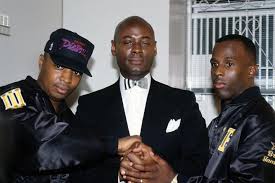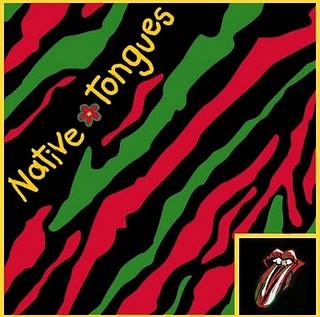Ernie Paniccioli: Public Enemy’s Private Photographer

Ernie Paniccioli leaned in close. “Yo, take a minute,” he insisted. “You’ve got to listen to this from Public Enemy!”
Ernie is a big man, big enough for anyone with sense to pay attention. The song “Everything” starts to play, and the words fill the room. It’s a soulful litany of all the things Chuck D, the group’s leader, does not have, and the things he needs.
Never was hot/Never was pop
But I never, ever stopped/That real hip-hop.
Got no paparazzi/Got no company that got me
Walking alone in the hood/So it’s easy to spot me.
Who needs paparazzi when you have Ernie? An imposing chronicler of the hip-hop scene from LL Cool J and Biggie Smalls to Queen Latifah and Lil’ Kim, Ernie has been especially close to Public Enemy, counting its members as collaborators, conspirators and counselors. It has been a good month for them: Public Enemy will be inducted tonight into the Rock and Roll Hall of Fame, and Ernie recently finished a conference at Cornell University, whose library acquired his vast photographic archive.
It’s been a big climb for the self-taught photographer and Native American activist who prizes creativity and social consciousness. Decades ago, Ernie, now 66, fell in love with the street art, music and dance created in Harlem, Hollis and the South Bronx by young people who had little money but plenty of imagination. But even as some of them became stars, he always sought that glimmer in their personalities that had ignited the culture decades earlier.
“My work shows them as larger than life but also as part of life,” Ernie said. “My work has a pulse. It three-dimensionalized a lot of these people. And the artists themselves have always let me be up close and personal. There never been dichotomy between the photographer and the artist. It’s a circle.”
That approach carried him through the decades. He started in the 1970s by photographing graffiti murals on his way to work for a telephone company, then moved on to B-boy battles in clubs and rap concerts in community centers and concert halls. He became the go-to photographer for magazines like Word Up and Rap Masters, and a generation of young people grew up with Ernie’s pictures on their walls. He has published several books, including “Who Shot Ya,” and was the subject of “The Other Side of Hip-Hop,” an award-winning documentary.
Ernie grew up in Bedford-Stuyvesant, Brooklyn, but ran away from home when he was a teenager. He hung around Greenwich Village and befriended the singer Richie Havens, who taught him about art. He spent six years in the Navy and then returned to New York, where he married and had a child. Though he worked as an analyst for the phone company, the graffiti murals he saw in Manhattan Valley led him to borrow a camera.
 Ernie Paniccioli LL Cool J on Liberation Rock in Queens, 1994.
Ernie Paniccioli LL Cool J on Liberation Rock in Queens, 1994.One thing led to another as he went from taking pictures of murals to photographing spray-painted denim jackets worn by early B-boys and their fans. Soon, he was being hired to take pictures in clubs for $100 a night. In time, his improvised start led to steady magazine work. And he could go anywhere, any time.
“There were cats who got beatdowns, some photographers who got jacked,” he said. “I have a certain look or air that does not invite some cat who’s 19 and weighs a buck twenty-five to step to a guy who’s 260 pounds and look like Cochise.”
But one encounter threw him. One day, while taking some film to be developed, he heard something new.
It was Public Enemy. The sound, the attitude, the politics moved him.
The lab technician said he knew the group, and within a week, Ernie was meeting with Chuck D, Flavor Flav, Terminator X, Professor Griff and the S1Ws.
“Immediately, we became family,” Ernie said. “I felt I was in the presence of people who had the potential to create revolutionary change, not in the physical sense but in the mental sense. Chuck always reminds us. He’s always saying, ‘Yo, wake up! Check it!’ He’s like the alarm clock that Flavor wears.”
The feeling was mutual.
“He was very well in tune with where we were coming from,” Chuck D said. “He was not oblivious to struggle. One thing about Ernie was he was able to encompass all of P.E. in the shots, and that set him apart from others who only saw me and Flav. He considered the sum of all the parts to be important, and that endeared him to all the members of P.E.”
In the 1990s, when he was laid up from knee surgery, Ernie got a call from Chuck, who wanted him to do a cover shoot for Terminator X, the group’s D.J.
“I can’t,” Ernie said. “I’m on crutches.”
“You’re broke,” Chuck replied. “Is your finger broke?”
“No,” Ernie said.
“I’ll have the S1Ws pick you up and hold your camera,” Chuck said. “You just flick it.”
“Well,” Ernie said, “they picked me up, carried me out to the parking lot for the shoot and put me on my back. But I took the shot — shooting up.”
The curators at Cornell — whose growing hip-hop archive also includes work by Charlie Ahearn and Joe Conzo — said Ernie’s evident rapport with various artists was among the reasons they acquired his work, which includes as many as 70,000 images of stars, fans and fashion.
“The range is the most significant feature of his archive,” said Ben Ortiz, the assistant curator of the collection. “He had access that just blows my mind. There’s a particular photo with Treach from Naughty by Nature jumping on Biz Markie’s back on the street. It looks like they’re celebrating something. Ernie said that was the moment they heard about the O. J. verdict.”
That image hints at another theme in Ernie’s work: a political sense, at times controversial, that once motivated performers. He is equally outspoken about rap pioneers who do little but rest on faded glories and about current ones who have no lyrical prowess but make millions as little more than shills driven by false pride and money.
“That ended up diluting something that was organic into something that is not,” he said. “It became a marketing gimmick. Now rappers look like professional wrestlers. Fancy names, fancy personas. Imaginary characters in an imaginary world. But at one point it really mattered.”
 Ernie Paniccioli Chuck D in Soho, 1995.
Ernie Paniccioli Chuck D in Soho, 1995.



![[EVENT] SWAG (@SWAGArt) – #ElementsArtExhibit 4/13 & #FirstFriday @ Drink Philly](http://iamnotarapperispit.com/wp-content/uploads/2013/03/0f4a22f093fd11e2ab6722000a1fb853_7-612x317.jpg)

Ernie Paniccioli: Public Enemy’s Private Photographer http://t.co/azVrHPTLKe
Ernie Paniccioli: Public Enemy’s Private Photographer http://t.co/78Ak2Gk81B
Ernie Paniccioli: Public Enemy’s Private Photographer http://t.co/SmSUHAju6F
Ernie Paniccioli: Public Enemy’s Private Photographer – http://t.co/Bq8wStFYPP
Ernie Paniccioli: Public Enemy’s Private Photographer – http://t.co/yfUs7krRMV